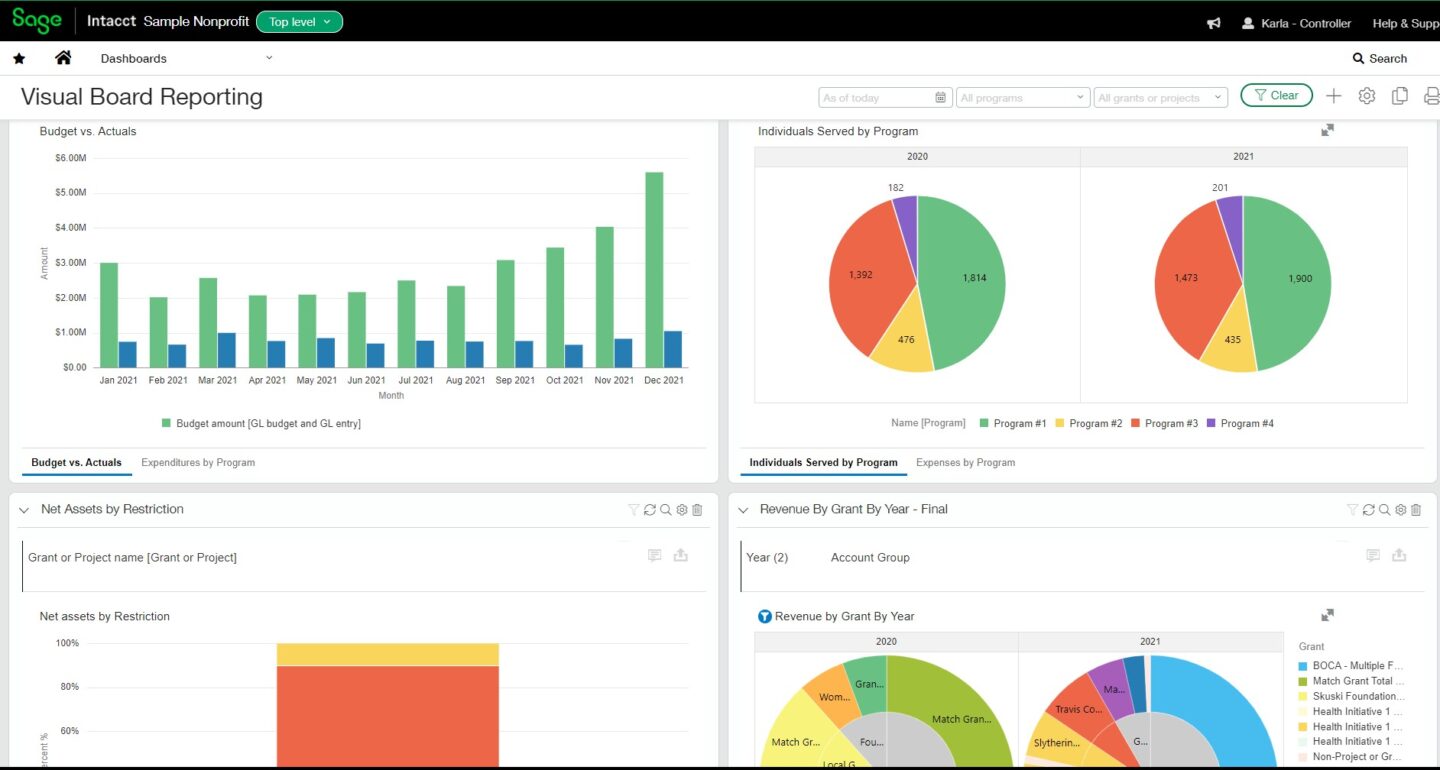Dashboards for Nonprofits – 5 Examples to Inspire You

Imagine a dashboard as the control center of your nonprofit organization—a place where all of your key metrics, data, and insights come together in one visually appealing interface.
It is like having all the dials and gauges you need to monitor your organization’s performance in real-time at your fingertips.

In this article, we will explain the purpose of dashboards for nonprofits and reveal why they are a powerful tool for executive insight.
We will present five examples of dashboards in Sage Intacct that provide nonprofit leaders with real-time, curated insights, and data visualizations that improve visibility and help with planning and decision-making.
Here’s what we’ll cover
What is a dashboard?
A dashboard is a visual representation of data that makes it easy to track performance, monitor trends, and identify areas for improvement.
Cloud-based nonprofit accounting software, like Sage Intacct, enables nonprofits to quickly customize dashboards to deliver at-a-glance insights for specific roles, programs, and reporting purposes.
With a well-designed dashboard, nonprofit leaders can quickly assess how well programs are performing. They can also track fundraising progress and identify areas for improvement.
Instead of sifting through endless spreadsheets or reports, dashboards present data in an easy-to-understand format that helps leaders make faster, more informed decisions.
But dashboards for nonprofits are more than just pretty graphs and charts.
They empower teams with real-time insights that drive action and impact.
By leveraging the power of data visualization, nonprofits can transform complex data into decisions that deliver positive change and support the mission.
“In addition to the tremendous value of Sage Intacct’s dashboards and dimensions, it’s a great advantage to bring statistical information into the system so easily.
Frank Fieseler, CFO & COO, Brevard Zoo
We monitor daily attendance from our members and the general public, and love that we can now marry the zoo’s financial information with these numbers.
As a result, we can react quickly versus waiting until month-end to see if attendance makeup, food sales per capita, or other trends are out of their normal range.”
Let’s examine five types of dashboards available in Sage Intacct.
We’ll explore how each plays an important part in managing financial health, demonstrating impact and accountability, and achieving mission success.
1. Role-based dashboards
A role-based dashboard serves as a tailored tool that caters to the unique needs and responsibilities of different individuals within an organization.
You can create a dashboard for your Executive Director, CFO, Controller, Program Managers, even your Auditor.
These dashboards empower users to make informed decisions and take strategic actions that drive organizational success.
Rather than searching for information relevant to their job function or programs, a role-based dashboard streamlines information delivery, displaying the most pertinent insights.
Ultimately, role-based dashboards help increase individual efficiency, enhance collaboration, improve decision-making, and align individual efforts with organizational goals.
As an example of a role-based dashboard for nonprofits, the Sage Intacct dashboard below was designed for a nonprofit CFO.
As you can see, this dashboard includes a mixture of report windows and data visualizations most pertinent to a nonprofit CFO.
It also includes a mixture of outcomes KPIs and financial performance data.
The CFO can see the big picture not only in terms of revenue and expense but also in terms of mission impact and results.

Tom Bland, CFO, International Living Future Institute
“During our monthly operations meetings, everyone’s able to look at their personalized Sage Intacct dashboards and see what’s going on in their part of the organization at that moment.
It’s increased accountability across the team, and our CEO always knows if we’re on track with revenues and expenses.
She can spot problems early on and ask the right questions of a specific department or program to help resolve them quickly.”
2. Outcome metrics dashboard
To make the biggest impact, it is essential to determine which programs and activities produce the best outcomes.
Measuring outcome metrics allows you to determine whether the actions your organization undertakes achieve the intended results.
Outcome metrics combine financial and operational data to provide an accurate picture of impact and program efficiency.
Examples of nonprofit outcome metrics include:
- Number of meals served and cost per meal
- Number of patients seen and average cost per patient seen in different practice areas
- Number of clean water wells drilled and the number of people served with water per dollar spent

The above dashboard gathers useful outcome metrics on a single screen. It helps nonprofit leaders keep an eye on mission impact at all times.
Having a similar outcome metric dashboard—tuned for your organization’s mission—can benefit your organization by helping you:
- Measure effectiveness
- Expand impact
- Demonstrate stewardship and provide accountability to funders
- Identify underperforming programs to cut or change
- Win or unlock additional funding
“The CEO and I often leverage our operational dashboard in Sage Intacct, which displays important KPIs for the organization, such as our average cost per site visit or per customer training, to drive key decisions.
Mark Paepcke, CAO, Public Health Accreditation Board
It also helps us benchmark our fee revenue to grant revenue ratio and monitor our average revenue by health department size, so we can see the mix of both revenue and expenses coming in and know whether they are tracking against what we expected for the year.
3. Nonprofit Digital Board Book
Nonprofits need a holistic view of their organization to drive mission impact and ensure good stewardship of financial resources.
The right dashboards can help nonprofit decision-makers gain insights that will help guide planning, strategy, and fundraising efforts.
Additionally, comparing financial performance to nonprofit industry benchmarks and best practices can be especially helpful for nonprofit decision-makers seeking to optimize impact.
Sage Intacct offers the Nonprofit Digital Board Book—a set of ready-to-use dashboards that incorporate industry standards to help nonprofit leaders gauge organizational financial health and sustainability against best practice metrics.
By integrating data from various sources such as balance sheets, revenue and expense reports, donor management systems, and budgeting software, the Nonprofit Digital Board Book offers real-time graphical representations of essential metrics for decision-making.
Nonprofits use these dashboards to monitor balance sheet performance, funding sources, and overall revenue mix, ensuring long-term stability.

“Our CEO and board of directors have recognized how valuable Sage Intacct’s real-time dashboards are to the business because they increase our credibility and help executives better manage day-to-day operations.
David Teske, Director of Finance & Administration, ACUI
Rather than creating dozens of different reports for various departments, we can get the right information to the right groups by putting top-level reports on a dashboard, and letting the appropriate staff or volunteers adjust filters to see whatever region, department, or sub-cost centers they care about.”
4. Interactive Visual Explorer dashboards
It is said a picture is worth 1,000 words.
Similarly, a good data visualization can be worth 1,000 lines of an Excel spreadsheet in nonprofit finance!
One of the biggest benefits of cloud-based nonprofit financial management is the ability to explore data in real time through charts and graphs, spot trends, and then drill deeper for more detailed analysis.

Sage Intacct Interactive Visual Explorer is an interactive visual analysis tool for nonprofits that helps decision-makers explore financial and operational data from multiple angles.
By visualizing real-time performance data, leaders can identify trends quickly and adapt strategic plans to drive operational and mission success.
Featuring a library of more than 200 prebuilt visualizations, nonprofits can quickly create dashboards that incorporate visualizations tailored to their precise needs.
Choose from over 25 visualization types and apply filters in just a few clicks to create the necessary visualization.
You can even insert visualizations into reports to distribute at-a-glance insights to board members or other decision-makers.
“With the Sage Intacct custom dashboards, we’re equipping people outside the finance team with the specific real-time data they need.
Maggie Leaptrot, Director of Finance, Yeager Airport
Since they always have visibility into where they stand with actuals, they’re better able to stay on budget. It’s made finance more approachable and, in turn, a better partner to the whole organization.”
5. Compliance dashboard
A compliance dashboard can help the finance team maintain compliance with nonprofit accounting standards for financial statements.
In Sage Intacct, the Compliance dashboard displays real-time audit and tax information, including the Statement of Activities and Statement of Operations.
Furthermore, the dashboard includes portions of an organization’s Form 990, including the Statements of Revenue and Functional Expenses.
The dashboard can enhance collaboration with an outside auditor and ensure financial transparency.

“Sage Intacct dashboards at our fingertips are a very valuable tool.
Daniel Gould, Vice President of Investments and Operations, Marguerite Casey Foundation
In finance, we can monitor cash levels and the upcoming payables workload.
Our operations specialist created a dashboard for vendor review processes, where we keep the vendor data clean, up to date, and in one place.”
Final thoughts
Dashboards for nonprofits supply an ever-ready window into your organization’s financial and operational health.
Real-time dashboards can help every member of your team spot trends, improve results, and perform more effective planning.
For many people, dashboards are more effective than reports because visualizations make it easier to consume information and derive meaningful insights.
Dashboards can be customized to include evergreen information specific to different roles and operational areas.
Dashboards enhance collaboration and provide a great way to:
- measure impact
- monitor outcomes
- demonstrate accountability with the executive team, the board, and funders.
Download the Achieving Real-Time Visibility with Nonprofit Financial Reporting and Dashboards e-book to see how dashboards for nonprofits can place you in front of the control panel to launch mission impact to the next level.
About the author

Nancy Master
Nancy Master is a senior nonprofit industry marketing manager at Sage Intacct and is passionate about helping nonprofits achieve mission success.
She has more than 15 years of experience in software marketing and close to 20 years of experience working with a human services nonprofit organization.

Ask the author a question or share your advice